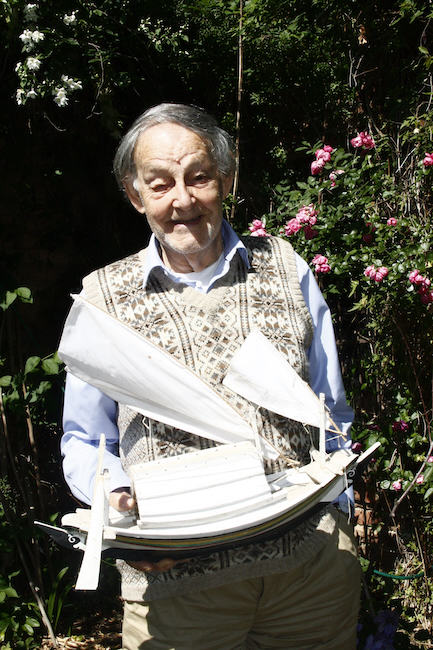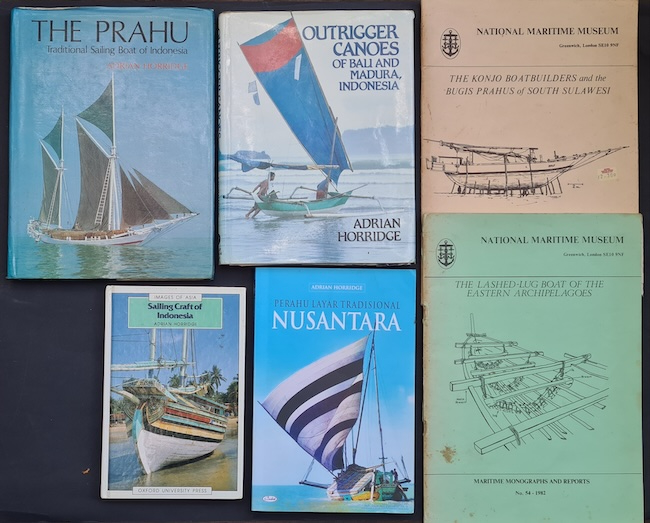From distinguished neurophysiologist to maritime historian
Adrian Horridge was a founding Professor of Behavioural Biology at the Australian National University who took a sudden, unexpected mid-career detour. Over a decade of part-time field research, he became the world’s leading expert on the distinctive forms of traditional Indonesian seacraft. Meanwhile, he continued his laboratory work in neurophysiology, establishing himself as a world authority on honeybee vision. He kept publishing on this topic right up until his death in April this year, at the age of 96.
His recordings from the mid-1970s of Indonesia’s unique maritime world were timely and significant. He encountered a little-known cultural tradition of boat building and seamanship found nowhere else in the world but in the vast tropical archipelago to Australia’s near north. At that time, this was the world’s largest and most diverse surviving fleet of engineless working sail craft, ranging from outrigger dugouts to large sail traders.
Built beneath palm trees using simple hand tools and natural materials, these vessels had survived to meet the needs of a struggling post-colonial economy spread across the world’s largest archipelago. Many of these unique and often ancient local designs, would soon disappear as the country modernised and fleets became motorised.
Professor Horridge’s detailed, analytical studies appeared in numerous books, monographs, and scholarly essays. They threw light on the maritime technologies that had enabled closely related cultures, the Micronesians and Polynesians, to settle the Pacific Ocean, launching their voyages from island Southeast Asia. His work also deepened our understanding of the historic voyages to Arnhem Land and the Kimberley that connected Indonesian seafarers with Australian First Nations people since pre-colonial times.
Born in Sheffield, Yorkshire, in 1927, his education was disrupted by teacher shortages during World War II. At 17, he won a scholarship to St John’s College, Cambridge, where he gained first-class honours in natural sciences and a PhD on primitive nervous systems. During this time, he studied jellyfish, coral, and anemones on expeditions to the Mediterranean and Red Seas.

In lieu of national service he served as a scientific officer in the Royal Aircraft Establishment at Farnborough, England, which taught him about making strong, light structures for aircraft and missiles. He credited this experience, along with his knowledge of biological structures and adventurous cruising yacht voyages on the North Sea, with helping him interpret the unfamiliar designs of Indonesian timber boats held together by wooden pegs and rattan bindings.
In the 1950s and ‘60s he was a lecturer at St Andrews University, Scotland, director of its Gatty Marine Laboratory, a visiting professor at the Universities of California and Yale and worked at Woods Hole Marine Laboratory in Massachusetts.
In 1969 Adrian Horridge was elected a Fellow of the Royal Society for ground-breaking discoveries in marine invertebrate neurophysiology. That year he was also appointed as one of the founding professors of ANU’s School of Biological Sciences, relocating to Canberra with his wife and children.
In 1975 he led an Australian team of marine biologists on an American research ship, the Alpha Helix, exploring the remote Banda Sea of eastern Indonesia. While studying the optic nerves of mantis shrimp he noticed exotic-looking local vessels working under sail, and being built on village beaches. This piqued his curiosity and, finding little written about them, over the next decade he returned whenever he could to study and record them himself.
For this he learned Bahasa Indonesia, making 15 field trips to remote island communities as well as liaising with Indonesian and Malaysian scholars and institutions. He also studied old ethnographic boat models held in museum collections of former colonial powers, in the Netherlands, Germany, UK and the USA.
In September 2024 I spread his ashes in the harbour of Banda Neira, his base during the 1975 Alpha Helix expedition that sparked his interest in Indonesian maritime ethnology and material culture.

Every maritime culture finds its own solutions to the universal challenges of seafaring, and to the unique facets of its own marine environment. Applying its own technology and aesthetics, their seacraft become unique cultural expressions. Adrian Horridge’s work has preserved much of this now-vanished heritage for future Indonesians – and others – to study and enjoy.
Survived by a son, four daughters, four grandchildren and three great-grandchildren, he has bequeathed his research archive to the Australian National Maritime Museum, Sydney. It includes over 10,000 fieldwork photographs, a large research library, manuscripts, maps, Indonesian boat models and boatbuilding tools.
Jeffrey Mellefont (jrmellefont@gmail.com) is a Research Associate of the Australian National Maritime Museum where he was a founding staff member 1987-2014.












